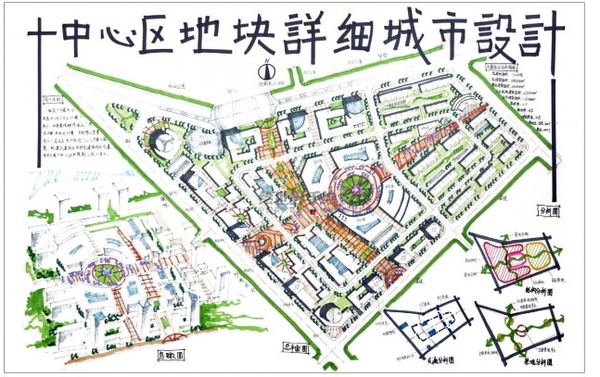Characteristics of urban planning in China
5 min readA Concrete manifestation of new china’s Cultura r econstruction.
In the modern world, China is both a developing nation and a newly emerging socialist state. Coming from an ancient cultural tradition, she now faces a new era of unprecedented social change. While overhauling her backward economy and actively pursuing reconstruction and modernization, she is also rapidly developing a new socialist culture. In the process of modernization and reconstruction, it is necessary for China to adopt the foreign science and technology according to her own needs But the development of a new socialist culture, however, entails a more important and complex problem: how to identify and preserve the valuable part of China’s own traditional culture.

With the growth of world urbanization in recent times, city planning as specialized science has become more complex and more important each day. But it is not a new science, as it was already flourishing in some of the great civilizations of antiquity. Ancient China was no exception, and Paul Wheatley has drawn particular attention to the symbolic nature of the “ideal “planned layout of ancient China’s cities citing corroborative evidence in the Book of Artificers (Kao Gong Ji). One of the outstanding features of the ideal layout is the north-south axis of the whole city, and this axial design is superbly executed in Pei-Ching[ Beijing The book of Artificers was completed around the fifth century B. C and deals primarily with manufacturing technology. It also records the plan for the construction of the imperial capital, which is somewhat ambiguous and has been subject to varying nterpretations and reconstructions. The main points of the plan include the following.
First, the capital should be laid out as a square, surrounded by a city wall; each side should extend nine li(Chinese mile, equal to about 1/2 kilometer) and contain three city gates. Second, within the city there should be nine longitudinal and nine latitudinal thoroughfares, or three longitudinal and three latitudinal thoroughfares, each consisting of three chariot lanes. Third, in the center of the capital is the Imperial Palace of the emperor on the left side of the imperial palace is the tai miao where he worships the gods of soil and grain The front part of the Imperial Palace is th ere the emperor pays homage to his ancestors. On the right side is the Sheji Tan, “wh emperors administrative center, and to the rear of the Imperial Palace is the capital’s main market and commercial center.
These declarations in the book of Artificers refer to the capital and largest city of the empire: left, “right, front, and “back refer to the four cardinal directions (respectively east, west, south, and north). The Imperial Palace of the emperor faced true south and was located in the geometric center of the whole city. Tai Miao(the Imperial Ancestral Temple) lay to its east, She-ji Tan(the Altar of Soil and Grain) lay to its west, and the city market to its north. The city was aligned along a north-southaxis, facing the south and with its back to the north. This orientation bore a close relationship to the residential traditions of the lower reaches of the Yellow River (Huang Ho), where Chinese civilization originated. The plains of the lower Yellow river, small ones such as the Jing-Wei and Yi-Lo Basins as well as the great North China plain have a flat and open topography. They are located in the temperate zone, characterized by strong prevailing monsoons and four distinct seasons, with hot, rainy summers and cold, blustery winters. In order to maximize ventilation in summer, while in winter providing maximum exposure to the sun and shelter from the cold north wind, residential structures in this area were built to open toward the south, with their backs to the north Over time these evolved into the si-heyuan (house built around a courtyard). The si-he-yuan has structures facing the center on all four sides, with the principal one, called the zhengfang, on the north.
The si-he-yuan is, in fact, the “cell”of traditional chinese city structure. If the streets and alleys defined by rows of si-he-yuan are arranged in a certain pattern and surrounded by a wall, a city is formed. The emperor’s palace in the national capital was simply a grand si-he-yuan, or a collection of them, surrounded by a palace wall and referred to as the Gong Cheng or Imperial Palace. The Imperial Palace was supposed to have a dominant position, at the center of the city’s primary north-south axis, and this central location symbolized the center of the cosmos. Also, according to ancient custom the Tai Miao”could only be built in the nation’s capital China is an agrarian nation, and the”She-ji Tan”was an important symbol of the emperor’s authority. As for the market, it was a necessity of city life. All these basic elements of the city were clearly set forth in the book of Artificers. Of all the written works concerning the construction of the capital city which have been passed down from antiquity, this is the earliest and most important, and had the greatest influence on the actual design of the ancient capitals.
Of the several imperial capitals in Chinese history, the last built was Beijing, or more specifically, that part of modern Beijing referred to as the Old City, and it is the actual design of this city that comes the closest to expressing the ancient principle of palace in front, market in back, ancestral temple on left, altar of soil and grain on right. After the foundation of New China, the capital was re-established in Beijing with its center in the Old City, and work commenced to build a people’s capital”fo the new socialist era. Thus, the redevelopment of Beijing,’s Old City plan became an urgent task. In order to fully understand the nature of this task, it is necessary to examine the plan of Beijing’s Old City in some detail Early Planning and the rise of Dadu City.








